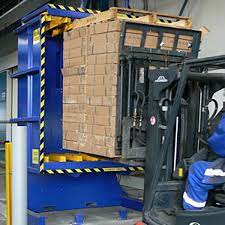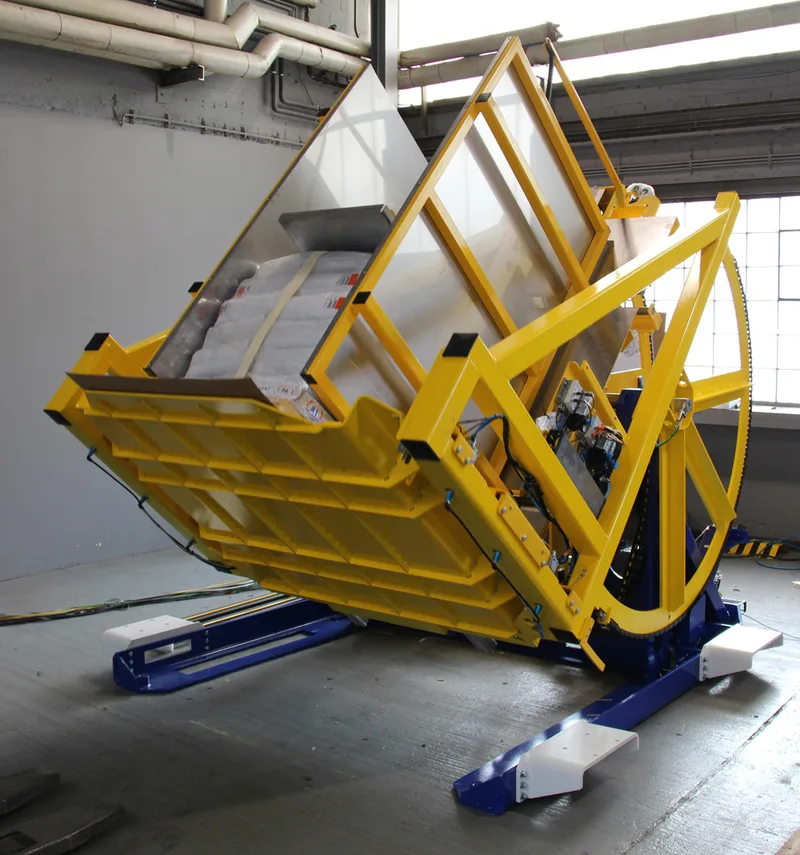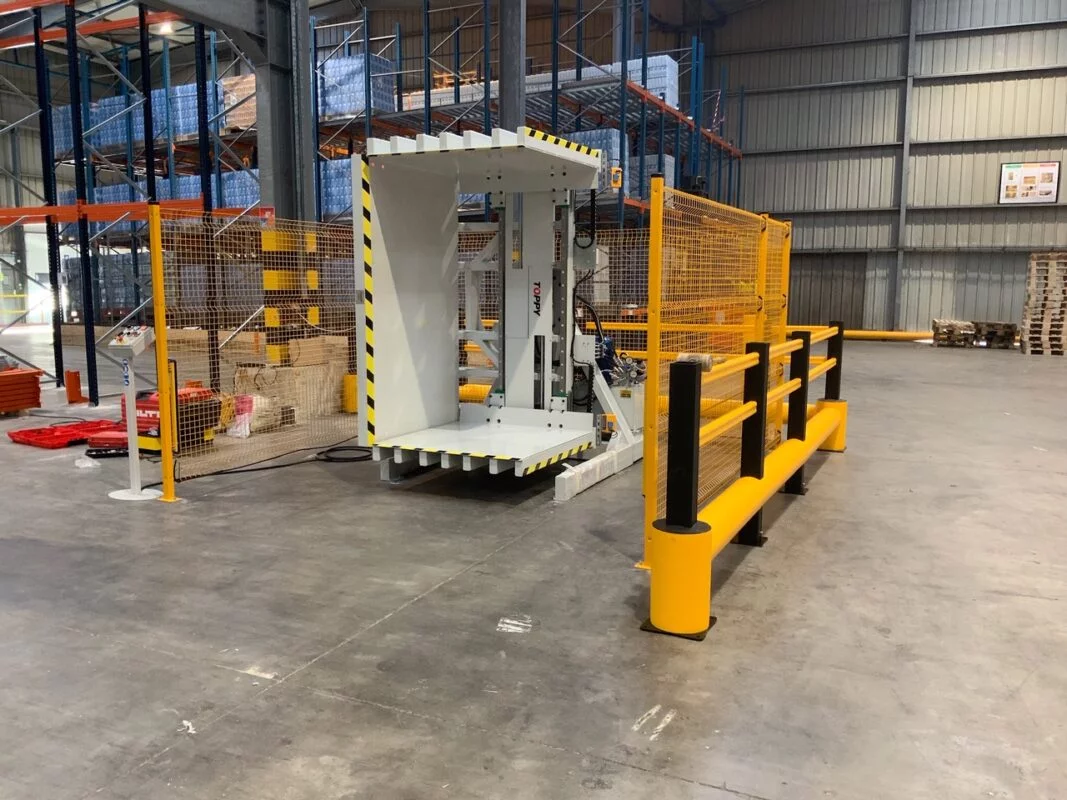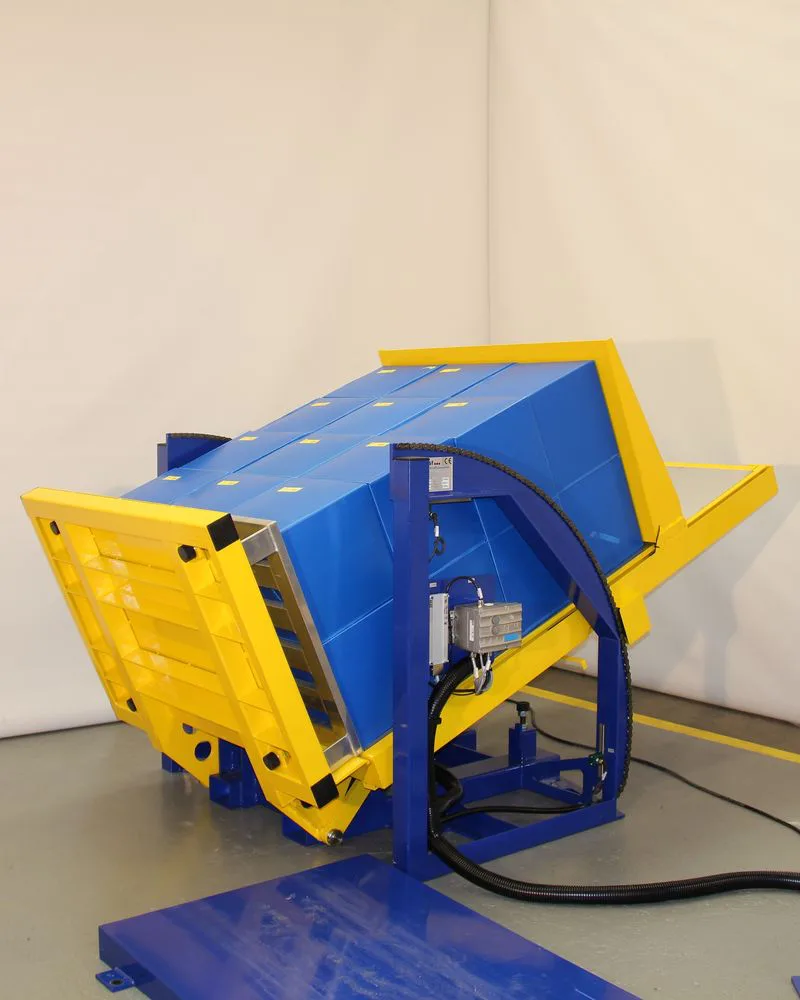Pallet Changing Machine: What’s the Fastest Way to Swap Heavy Component Pallets?
Handling heavy component pallets, like those with steel coils or large engine parts, often creates a significant bottleneck in the logistics chain. The manual process is slow, physically demanding, and poses a real risk of injury to your team and damage to your valuable products. This inefficiency can ripple through your entire operation, causing delays that frustrate customers and eat into your profits. As someone who has spent his entire career on the factory floor, I have seen firsthand how these seemingly small problems can lead to big financial losses.
The fastest and most efficient way to swap heavy component pallets is by using an automated pallet changing machine, often called a pallet inverter. This specialized equipment securely clamps the entire load, rotates it, and allows for a quick pallet exchange in under 60 seconds. This method drastically reduces manual labor, minimizes product handling risks, and creates a seamless flow in your production or warehouse environment.

But speed is only the beginning of the story. A machine like this is a serious investment, and as a business owner, you need to understand the full picture. It's not just about how fast it moves, but how it integrates into your existing lines, what type of machine is right for your specific product, and what the true return on that investment looks like. Let’s dive deeper into these questions so you can make a decision that benefits your operation for years to come. I built my business on making these kinds of practical, informed choices, and I want to share that knowledge with you.
How Does an Automated Pallet Changer Boost Throughput for Heavy Loads?
Your production line might be a model of efficiency, but if everything grinds to a halt at the final packaging stage, you have a problem. I've seen it many times: highly optimized manufacturing followed by a chaotic and slow manual process of moving heavy goods from production pallets to shipping pallets. This single bottleneck can undo all your hard-earned gains, creating queues, delaying shipments, and putting you behind schedule. It directly undermines any goal of achieving high operational uptime.
An automated pallet changer directly boosts throughput by replacing a slow, variable manual task with a standardized, predictable cycle that takes less than a minute. This eliminates worker and forklift waiting times, ensures a continuous flow of goods from your production line to the loading dock, and allows you to process more volume with the same or fewer resources.

Breaking Down the Throughput Gains
Throughput isn't just a number; it's the lifeblood of a manufacturing plant. When we talk about boosting it with a pallet changer, we are looking at concrete improvements in several key areas. From my experience helping clients, the impact is felt almost immediately.
Drastic Cycle Time Reduction
The most obvious gain is speed. A manual pallet swap for a heavy, unstable load can take two or more workers 10-15 minutes, if not longer. There's the time to bring the forklift, the careful de-stacking, the restacking, and the removal of the old pallet. An automated pallet changer performs this entire sequence in a single, fluid motion.
| Metric | Manual Pallet Swap | Automated Pallet Changer | Improvement |
|---|---|---|---|
| Average Cycle Time | 10 - 15 minutes | < 60 seconds | > 90% reduction |
| Labor Required | 2+ Operators | 1 Operator (often the forklift driver) | > 50% reduction |
| Consistency | High variability | Highly consistent | Eliminates delays |
| Safety Risk | High (strains, falling items) | Very low (fully contained process) | Reduces liability |
Unlocking Your Labor and Equipment
When you automate a task like pallet changing, you are not just making that one step faster. You are freeing up your most valuable assets: your people and your equipment. The forklift and operator that were tied up for 15 minutes are now free after just one minute. This means that same forklift can be used for other critical tasks, like loading trucks or supplying the production line. Your personnel are no longer engaged in a low-value, high-risk task. They can be retrained for quality control, machine supervision, or other roles that add more value to your product. This is a direct way to lower operational costs without reducing headcount.
Eliminating Errors and Rework
Manual handling of heavy components is prone to error. Products can be dropped, stacked incorrectly, or damaged during the transfer. Each error leads to rework, wasted materials, and sometimes, a completely scrapped product. An automated system handles the load with precisely calibrated pressure and a smooth, controlled motion. It eliminates the human error factor. This leads to higher quality, less waste, and a more reliable output, which are all critical goals for a modern steel mill or any heavy manufacturing facility.
What Are the Key Differences Between a Pallet Inverter and a Pallet Changer?
You have decided you need to automate your pallet swapping process. But when you start looking, you see different names: pallet inverter, pallet exchanger, pallet transfer system. The terminology can be confusing, and choosing the wrong type of machine for your specific application is a costly mistake. I’ve seen companies invest in a system that couldn’t handle their product’s unique shape or weight, leading to a machine that sits unused.
A pallet inverter is a type of pallet changer that works by clamping the load and rotating it 180 degrees to swap the pallet. This is the most common and versatile solution. The term "pallet changer" is broader and also includes systems that push the load from one pallet to another without rotation, which are suited for loads that cannot be turned upside down.

Choosing the Right Tool for the Job
Understanding the core mechanics of each system is essential. The right choice depends entirely on your product, your space, and your process flow. As an engineer, I always start with the load itself. What are you moving? The answer dictates the technology you need.
The Pallet Inverter: Strength in Rotation
This is the workhorse of pallet swapping. The process is simple and robust.
- A forklift places the loaded pallet into the machine.
- Two clamping tables press against the top and bottom of the load, securing it firmly.
- The entire assembly rotates 180 degrees. The original pallet is now on top.
- The machine platform lowers slightly, separating the old pallet, which can be easily lifted away.
- The new pallet is placed on top, and the machine rotates back 180 degrees.
This method is ideal for stable, boxed goods, bagged products (like cement or chemicals), pails, drums, and even robust components like steel coils that are securely strapped. The full clamping action provides excellent support for heavy loads, preventing any shifting during the transfer.
The Pallet Changer (Push-Pull Type): A Gentle Slide
Some loads cannot be inverted. Think of open-top bins, fragile glass products, or bottles that would leak. For these applications, a push-pull system is the solution.
- The original pallet and a new pallet are placed side-by-side in the machine.
- A side wall moves in to support one side of the load.
- A pusher plate gently slides the entire load from the original pallet onto the new one.
This linear transfer is gentler but requires the load to be stable enough to be pushed. It is often used in the food and pharmaceutical industries, where hygiene and gentle handling are paramount.
Decision Matrix: Inverter vs. Changer
To help you decide, here is a simple breakdown. This is the kind of analysis I would do with a client to ensure they get exactly what they need.
| Feature | Pallet Inverter (180° Rotation) | Pallet Changer (Push-Pull) | Best For... |
|---|---|---|---|
| Load Type | Stable, robust loads that can be inverted. Boxes, bags, pails, strapped coils. | Fragile, top-heavy, or liquid loads that cannot be inverted. | Your specific product dictates the choice. |
| Speed | Very fast, typically under 60 seconds per cycle. | Slightly slower due to the linear movement. | High-volume operations. |
| Footprint | Generally more compact, as it operates in a single bay. | Can be larger, requiring space for two pallets side-by-side. | Facilities with limited space. |
| Load Stability | Excellent. The load is fully clamped and supported at all times. | Good, but relies on the product's own integrity to withstand sliding. | Heavy or irregularly shaped loads. |
| Cost | Often more cost-effective due to simpler, robust mechanics. | Can be more expensive due to more complex moving parts. | Budget-conscious investments. |
How Do You Integrate a Pallet Changing System into an Existing, Aging Production Line?
You see the benefits of a new pallet changer, but then you look at your factory floor. You have equipment that has served you well for over 15 years. You worry that bringing in a modern, automated machine will be a massive headache. Will it fit? Will it communicate with your old systems? How much downtime will it cause? This fear of a complex and disruptive integration is a valid concern for any plant manager.
Integrating a pallet changing system into an aging line is achieved through a careful, three-step process: first, a detailed site assessment to map workflow and space; second, choosing between a flexible standalone unit or an inline system; and third, planning the installation during scheduled downtime to ensure zero disruption to your core operations.

A Practical Roadmap for Integration
From my journey of building a factory, I know that new technology must serve the existing process, not the other way around. A good supplier doesn't just sell you a machine; they help you make it a seamless part of your operation. Here is how we approach it.
Step 1: The Foundation is the Site Assessment
Before any machine is recommended, a thorough analysis of your site is critical. This is not just about measuring floor space.
- Workflow Mapping: We trace the path of your goods. Where do they come from? Where do they need to go after the pallet swap? We identify the most logical location to place the machine to minimize forklift travel time.
- Floor Loading: Heavy components and the pallet changer itself exert significant pressure on the concrete floor. We need to confirm that the floor's load-bearing capacity is sufficient, especially in older buildings.
- Utilities: We check for access to the necessary power supply and compressed air if needed. Planning this in advance prevents last-minute surprises and costs.
Step 2: Standalone Cell or Fully Inline?
There are two primary ways to integrate a pallet changer. The choice depends on your volume and desired level of automation.
| Integration Type | Description | Pros | Cons |
|---|---|---|---|
| Standalone Work Cell | The machine is placed in an open area. A forklift brings a pallet, the machine performs the swap, and the forklift takes the new pallet away. | Highly flexible, easy to install, lower initial cost, can be moved if layout changes. | Relies on forklift availability, can be less efficient for very high volumes. |
| Inline System | The machine is integrated directly into a roller or chain conveyor line. Pallets feed in automatically, are swapped, and exit on the conveyor. | Fully automated, highest throughput, reduces forklift traffic. | Higher initial cost, less flexible, requires more planning and installation time. |
For an aging facility, a standalone work cell is often the best starting point. It provides 90% of the benefit with minimal disruption to your existing infrastructure.
Step 3: Installation and the Human Factor
The final piece is managing the installation and training. A good partner will work with your schedule to install the machine during planned maintenance shutdowns, ensuring you don't lose valuable production time. After installation, operator training is key. These machines are designed to be simple, but proper training ensures they are used safely and efficiently. We also focus on setting up safety measures like light curtains or physical guards to protect your people, which is always the top priority.
What is the Real ROI of a Pallet Changing Machine Beyond Just Speed?
You've analyzed the speed and efficiency gains. But as a business owner, you need to present a solid financial case for this investment. Speed is great, but it can be hard to translate directly into dollars and cents. You need to look deeper. If you can't justify the return on investment (ROI), the project may not move forward, and you'll miss out on significant, often hidden, cost savings.
The true ROI of a pallet changing machine extends far beyond cycle time. The most significant financial returns come from dramatically reducing workplace injury costs, eliminating product damage during handling, lowering pallet rental and transport fees, and improving your overall operational stability.

My Insights: A Business Owner's Perspective
When I started my own factory, I had to learn to think like an investor, not just an engineer. Every machine had to pay for itself. A pallet changer is a perfect example of an investment with multi-layered returns. Let’s look beyond the stopwatch and focus on the balance sheet.
Hard Cost Reductions You Can Bank On
These are the tangible savings that your finance department can measure.
- Reduced Labor Costs: This isn't about firing people. It's about reallocating your skilled workers from a dangerous, manual task to a higher-value supervisory or quality control role. You get more value from the same payroll.
- Eliminated Product Damage: Let's be conservative. If you have even a 0.5% damage rate on heavy components due to manual handling, what is that worth? For a steel plant with a 2 million ton annual capacity, the numbers become enormous. An automated system can bring that damage rate close to zero.
- Lower Worker Compensation Costs: Back, shoulder, and foot injuries from handling heavy loads are common and expensive. A single serious claim can cost tens of thousands of dollars in insurance premiums, medical bills, and lost time. A pallet changer is a powerful piece of ergonomic equipment that virtually eliminates this entire category of risk. This is one of the biggest and most immediate financial returns.
- Pallet Fleet Management: Many companies use high-quality internal pallets that they don't want to lose. By swapping loads to cheaper, one-way shipping pallets at the loading dock, you save the cost of losing expensive assets and reduce the weight and cost of your outbound freight.
Strategic Gains That Build Long-Term Value
These benefits are just as important and appeal directly to a forward-thinking CEO.
- Operational Stability and Predictability: A machine performs the same task in the same amount of time, every time. This predictability is the foundation of an efficient operation. It allows for better planning, tighter scheduling, and helps you achieve goals like 95% equipment uptime.
- Improved Customer Relations: When you eliminate damage and delays, your customers are happier. A clean, modern, and safe facility also enhances your reputation as a reliable, top-tier supplier.
- A Step Towards Digitalization: An automated pallet changer is a building block for a smarter factory. It can be integrated with your MES or WMS systems, providing valuable data and paving the way for further automation down the line. It's not just solving today's problem; it's preparing you for tomorrow's challenges.
I remember a client in the steel wire industry. They invested in a pallet inverter not just for speed, but because an injury had shut down their shipping department for a day. The real ROI for them was the guarantee that it would never happen again. That kind of stability is priceless.
Conclusion
A pallet changing machine is a strategic investment. It boosts speed, safety, and your bottom line, securing your operational future and turning a bottleneck into a competitive advantage.




